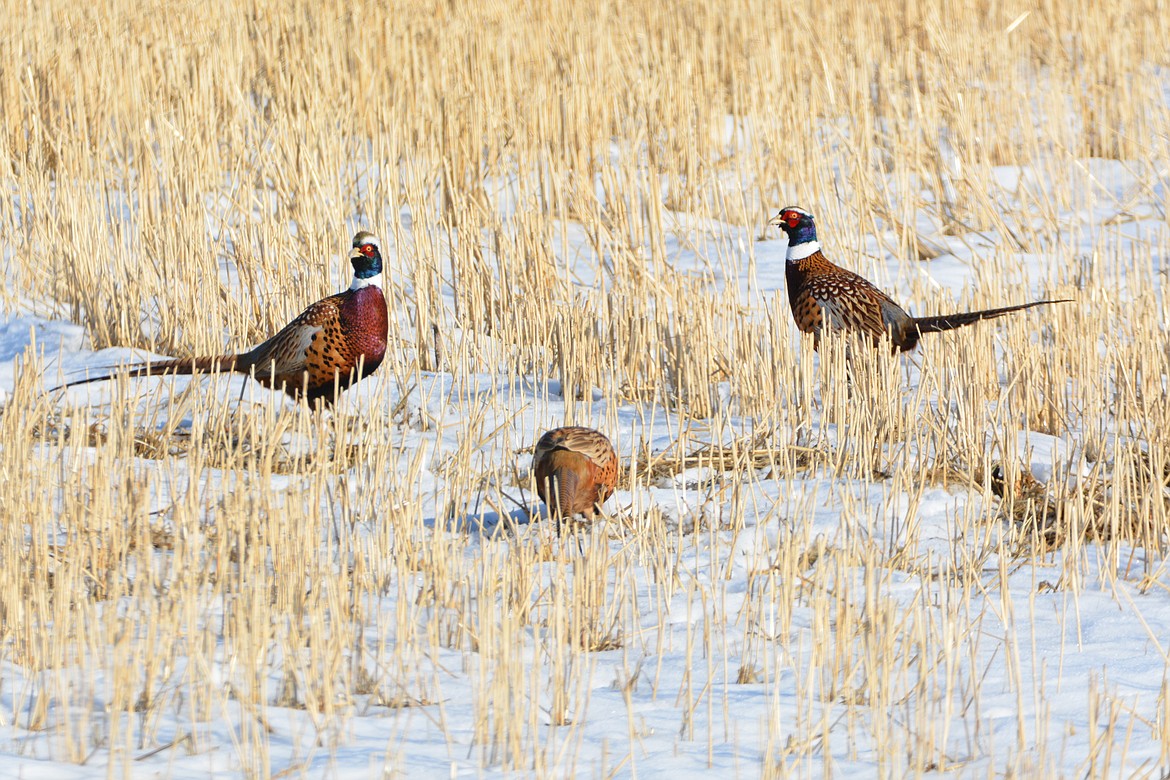The ring-necked pheasant can be found in county
In the fall mornings and evenings in Boundary County, moose, elk, coyotes, mule, and white-tailed deer might be seen. Osprey and shorebirds depart early in the season, while duck migration peaks in early November. Bald eagles arrive at the same time in search of sick or injured ducks that make an easy meal. However it was a ring-necked pheasant that caught my attention last week as I was traveling the Farm to Market road in northern Boundary County.
The beautiful rooster pheasant ran across the road in front of me and into the adjacent field. I barely had time to stop and get my camera out for a quick photo before he ran off into the field and to safety.
As I watched him on the edge of the wheat stubble I was reminded of a time in my youth when Dad took me on my first pheasant hunt at the age of 10. I didn’t sleep much the night before thinking about my first pheasant and the single shot .410 shotgun. At first light we were at the edge of a similar stubble wheat field, only it had 6 inches of snow blanketing the area.
We heard a rooster pheasant crow and I carefully walked to where the sound originated. I was startled by a cackling and a whir as the pheasant left the ground, shouldering my .410 shotgun I heard the muzzle blast and felt the recoil as the pheasant dropped to the ground. I can remember carrying the pheasant back to the pickup holding it firmly and proudly showed it to Dad. I think that was one of the proudest moments of my childhood.
However, this time on the Farm to Market road I was only armed with a camera and the pheasant was kind to hesitate and let me capture his beauty on film and in my memory before disappearing into the field.
Ring-necked pheasants are native to China and East Asia, but they have been successfully introduced in other parts of the world, including North America. Males are vibrantly colored with blue-green heads, red face wattles, and distinctive white neck rings. Females are a rather plain buff brown, but both sexes have long, pointed tails. These beautiful birds are wily in the wild and much sought after by game hunters. Thousands of them are harvested each year, but management and reintroduction programs boost many populations.
Males (also known as “roosters”) establish harems of hens — as many as a dozen female birds. Each spring a male delineates and defends his territory and his harem from aggressive rivals. Such encounters can lead to vicious battles.
During the nesting process the male defends the territory by taking a raised perch, giving crowing calls while briefly drumming with his wings. In courtship, the male struts in a half-circle around the female with back and tail feathers tilted toward her, with the near wing drooping and face wattles swollen. Nest sites are on the ground in dense cover. The nest is a shallow depression lined with grass, leaves and weeds.
The birds prefer fields and farmland with brushy cover, though they also inhabit woodland undergrowth and some wetlands. Females nest in fields or in border habitat and lay a dozen or more eggs, which they incubate with no help from the rooster.
Young pheasants grow up quickly and can fly within two weeks. They will remain with their mother for six or seven weeks. Many pheasant eggs are destroyed by predators or by humans (particularly in farm country), and young birds also have a high mortality rate. In autumn, ring-necked pheasants form flocks in which they will live until the following spring.
These birds are most comfortable on the ground, where they forage for grains, seeds, berries, insects, and, occasionally, small animals. They can fly and launch themselves airborne with an abrupt, noisy takeoff, but typically run from trouble. Pheasant flights are merely short-distance dashes for cover.
I did keep some feathers from my first rooster pheasant, when I was 10 and wore them in my cap like a proud banner. I posed with my gun, holding the pheasant high as Grandma Bee took the photo. The next night we did the tastiest part. We got to eat the bird!
I still hunt, but now it is with my camera and it is always loaded.
Enjoy Boundary County and all its wildlife.



